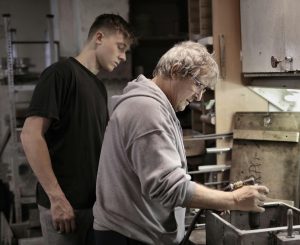I’ve done maybe 3- 4 posts on apprenticeships in the United States. The topic is once again top of mind having met a friend, who teaches the auto mechanics curriculum at a local high school, for lunch. He started teaching as a second career simply for the love of it after a regarding professional career in the auto industry. He wanted to give back.

Mikhail Nilo
It’s taken him 12 years to build the program. We toured around his facility on the high school campus. It is certainly the envy of most U.S. high schools…. A high ceiling cavernous indoor classroom with at least 6 cars in various stages of dis-assemble and rebuilding, connecting to an outside area maybe ¼ the size of a car lot with hydraulic lifters and other equipment. At the time of my visit students were working under his supervision on oil changes. We sat and talked about how students learn differently … how students had different aptitudes and affinities. And he pointed out a variety of special skills learned through his classes that could result in careers and livelihoods sufficient for a comfortable adult life… not just auto repair; welding, vintage car rebuilding which is a lucrative field and skills in the lucrative field of high-end designer car wrap techniques, just a few examples.

Olly 3846255
Then he talked about how frustrated he was by comments he over-heard shortly after floating the idea that he might be looking to retire in a few years. He over-heard, “So when he moves on will we be closing down the program?” This is the same mentality that led to trade occupations becoming almost extinct in U.S. school since the 1960s. The rise of colleges as profit centers, our kids being seen as dollar signs… the aggressive push and commercialization of 4 year college as the American dream…. As if the need/demand for skilled manual labor and crafts would literally vanish from relevance…… or almost intentionally forcing the demand out of existence. On the other hand, in communications via my private Facebook group, Mastering Adult Life Skills For Teens And Young Adults, I hear from parents and their young people not only questioning the relevance and value of 4-year university but also leaning into trade schools as their option of choice. And I’ve read in reputable media, and on the U.S. Dept. Of Labor website the U.S. has a need for over 3 million apprentices (and apparently, we are not even close).
The idea that not only are school administrators out of touch with student needs, learning differences, and affinities —but also out of step with demand for hands on skills and craftsmanship? Even if they are thinking of AI and robotics, which I doubt, the value of human interaction, the value and the trust and comfort that embodies… And the appreciation skilled crafters and, service providers will always be in demand.

Vlada Karpovich
The result of perspectives like these and U.S. Lack of investment and centralization may lead to these being offshored. Only 2% of U.S. teens/young adults participate in apprenticeship programs. This compares to 50% participation in Germany, with participation in Switzerland at high levels as well and U.K. participation rates growing substantially faster that in the U.S.
A big difference is that in Canada and European countries trade and apprenticeship programs for students are centralized and prioritized in terms of investment and time commitment. Germany and Switzerland have national programs of dual systems that fully integrate trade and apprenticeship programs with traditional education with strong industry/education ties and broad occupational coverage. The U.K. programs also have a national framework and Canada’s are Provincial. Currently, though interest is growing, in the U.S. the structure is extremely fragmented and investment in time and money are pretty much none existent compared to our high-income counter parts.
